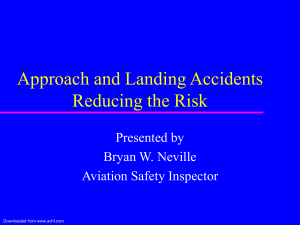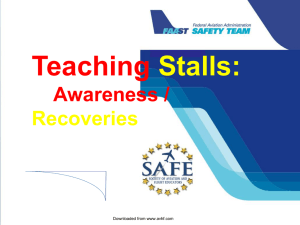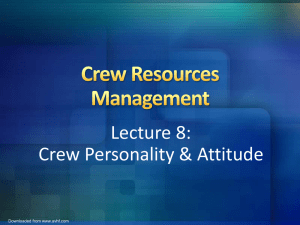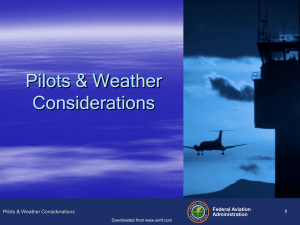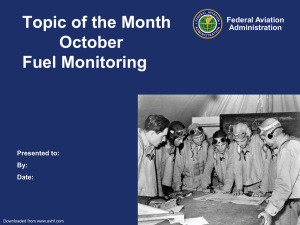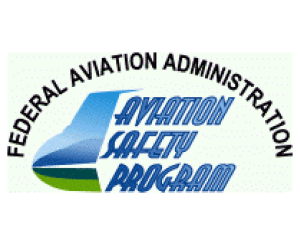CRM Show - Aviation Human Factors
advertisement
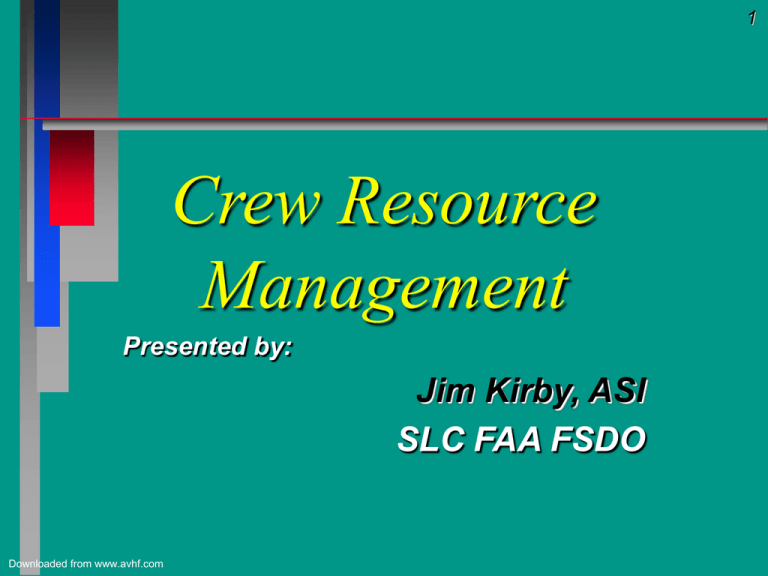
1
Crew Resource
Management
Presented by:
Jim Kirby, ASI
SLC FAA FSDO
Downloaded from www.avhf.com
2
Crew Resource Management:
“The effective use of all
available resources
needed to complete a
safe and efficient flight.”
Downloaded from www.avhf.com
3
Objectives:
We will explore:
Human factors that cause
accidents
Critical success factors and
elements
Concepts and tools of aircrew
coordination training (CRM/ACT)
Downloaded from www.avhf.com
4
Goals of CRM:
CRM should provide pilot with:
KNOWLEDGE of concepts and
procedures
ATTITUDE which recognizes the
importance of good aircrew coordination
to safety.
SKILLS to effect implementation of
knowledge
Downloaded from www.avhf.com
5
Quick analysis of past mishaps
ACCIDENTS, 1959 - 1990
70
60
50
40
30
20
10
0
60
Downloaded from www.avhf.com
62
64
66
68
70
72
74
Year
76
78
80
82
84
86
88
90
6
Who’s having accidents?
CAUSES OF AIRCRAFT ACCIDENTS
80%
Aircrew Error!
Downloaded from www.avhf.com
20%
WEATHER
EQUUIPMENT
MAINTENANCE
AIRPORT/ATC
OTHER
7
Who’s having accidents?
PERCENT OF TOTAL ACCIDENTS WITH KNOWN CAUSES ('59-'90)
Primary
Factor
No. of
Accidents
Flightcrew
493
Airplane
124
Maintenance
Airport/ATC
21
34
37
Misc (other)
47
Weather
Downloaded from www.avhf.com
10
20
Percent
30
40
50
60
70
8
Typical aircrew errors
Loss
of situational awareness
Violation of FAR
Departure from proven procedures
Poor judgment or decision making
Preoccupation with minor
mechanical problems
Downloaded from www.avhf.com
9
Typical aircrew errors
Inadequate leadership--Failing to:
Delegate tasks
Assign meaningful responsibilities
Set priorities
Lack of monitoring
Failure to use available information
Failure to communicate plans,
problems, etc.
Downloaded from www.avhf.com
The Aircrew Coordination (AC)
Cycle
E
G
N
E
L
L
A
H
C
R
E
S
The
Aircrew
Cycle
PLANNING
Downloaded from www.avhf.com
P
O
N
S
E
10
11
Critical Success Elements
TIME?
A
H
C
E
L
L
E
G
N
Downloaded from www.avhf.com
P
O
N
Available
S
Resources
Situational Decision
Aw areness Making
Workload
Performance
Policy &
Regulation
MONITOR
Operating
Strategy
R
E
S
Command
Authority
Aircrew
Communications
PLANNING
E
BRIEF
13
Guiding Principle:
“Everyone knows the
regulations and procedures
and will comply.”
(Fatal assumption?)
Downloaded from www.avhf.com
14
Would YOU . . .
Depart from
P&R?
Downloaded from www.avhf.com
15
Inadvertent Departures
Attention
Memory
Attitude
Stress
Downloaded from www.avhf.com
Purposeful Departures from
P&R . . .
Mind traps
Disregard for “silly”
rules
Pressure
Unwise commands
Downloaded from www.avhf.com
16
17
Positive Flight Crew Characteristics
In
control of people and events
or appear to be
Built-in calculated emotional
distance
Mission oriented
compartmentalizers
Systematic, methodical and
predictable
Downloaded from www.avhf.com
18
Negative Flight Crew Characteristics
Not
spontaneous
Can and do become complacent
as we get better
Do meaningless “rituals” - a trap
Need “positive feedback”
Downloaded from www.avhf.com
19
Assertiveness
Excessive
Halo
professional courtesy
effect
Copilot syndrome
Downloaded from www.avhf.com
21
Authority/Assertiveness
Crew Incapacitation:
Obvious
Subtle
“Two-Challenge Rule”
Downloaded from www.avhf.com
Conflict Resolution Techniques:
Constructive Patterns
Program time to discuss issues
Give expression to feelings
Replay other person's feelings
Define issues clearly
Discover where positions agree
Discover points of vulnerability
Determine depth of feelings
Offer self corrections
Recognize spontaneous humor,
caring
Downloaded from www.avhf.com
23
24
Command Authority
When there is disagreement:
“Conservative
Response Rule”
Downloaded from www.avhf.com
25
Communications
Levels
Downloaded from www.avhf.com
Poor
Good
Effective
26
Process of communications
Downloaded from www.avhf.com
Barriers. Anything that distorts or
interferes with communications:
Noise, static
Multiple
communications
Fatigue, stress
Distractions
Incomplete
message
Ambiguous
wording
Downloaded from www.avhf.com
Lack of credibility
Lack of rapport
Thing in personal
terms
Jargon
Boring
27
28
Was my message received?
Get feedback !
Deal with behavior, not person
Focus on ideas rather than giving
advice
Focus on what is said rather than
why
Include info that can be used, not
everything you know
Downloaded from www.avhf.com
29
Hidden Agenda:
Withholding information for
personal reasons
Insures loss of communications
Hard to detect
Taints judgment
Downloaded from www.avhf.com
30
Responsibility!
Sender
• Be clear &
concise
• Consider the
environment
• Address
receiver’s needs
Downloaded from www.avhf.com
Receiver
•
•
•
•
Active listening
Interpreting
Evaluating
Responding
31
Workload Performance
OPTIM UM WORKLOAD
HIGH
P
E
R
F
O
R
M
A
N
C
E
LOW
UNDERLOAD
Boredom
Fatigue
Frustration
Dissatisfaction
OVERLOAD
Prioritize
Delegate
Expand Time
Increase activity
LOW
Downloaded from www.avhf.com
OPTIMUM
WORKLOAD
Creativ e
Rational
Problem solv ing
Progress
Change
Satisfaction
SLOJ
Irrational
Problem solv ing
Exhaustion
Illness
Low self esteem
HIGH
32
Classifications of Workload:
CRITICAL: A workload item that
requires immediate attention to avert
catastrophe.
IMPORTANT: A workload item that
requires response as soon as
possible, else it will become critical.
ROUTINE: An item encountered in
normal flight, but if left unattended
could become important.
Downloaded from www.avhf.com
33
Work load too high
Work faster, try to cram more into a
shorter time frame.
Overall concept of flight breaks
down. Overall view begins to narrow
and become shorter
As pace quickens, attention become
tunneled--pilot fixates on one item.
Revert to previous habits (good or
bad)
Downloaded from www.avhf.com
34
Recognizing High Workload
Individual workload tolerance varies
Difficulty adhering to normal performance
standards
Errors, erratic performance
Getting away from good fundamentals of
aircraft control
Uncertainty, indecision, discomfort
Losing normal scan, tunnel vision, fixation
Temporal distortion
Hesitant, confused speech
Downloaded from www.avhf.com
35
Protecting against high workload
Intimate KNOWLEDGE of the
business
Professional ATTITUDE
SKILL to fly without excessive
attention to aircraft
Downloaded from www.avhf.com
39
Dealing with distractions
Ignore: Good during critical phases of flight.
Planning can reduce distractions.
Delay: If it can wait, then delay it (judgment
comes in here!)
Delegate: Let someone else handle the
distraction if it warranted.
Handle: Handle important distraction right
away, but do not become fixated at the
expense of other important functions.
Sterile cockpit: Reduces or eliminates
distractions
Downloaded from www.avhf.com
40
Stress
Can result in:
•
•
•
•
Downloaded from www.avhf.com
Distress
Anxiety
Oppression
Affliction
Body signals:
•
•
•
•
Headaches
Heartburn
Cramps
Fatigue
41
Stressors:
Downloaded from www.avhf.com
ENVIRONMENTAL
Cold/heat/light
Danger
Living conditions
PERSONAL
INTRAPERSONAL conflict
Hereditary traits
INTERPERSONAL
Personality conflict
Mistrust
Lack of support
Poor communication
PRIVATE LIFE
42
Stressors
Downloaded from www.avhf.com
Family problems
Financial concerns
Health care
Pressure from friends
Time for personal interests
ORGANIZATIONAL
Role conflict
Job ambiguity
Underwork/overwork
changes
Travel
People management
Organizational structure
43
Frequent Causes for a failing aviator
Recently engaged
Marital problems
Divorce
Relationship difficulties
Major career decision/change
Trouble with superiors or peers
Downloaded from www.avhf.com
44
Managing stress
Organize yourself
Change your environment
Build up your strength
Listen to your body
Learn to relax
Find ways to laugh each day
Develop a supportive network
around you
Downloaded from www.avhf.com
45
Available Resources:
People, equipment and information
that can contribute to a successful
flight and the prevention of error
during the flight.
Downloaded from www.avhf.com
46
Internal Resources:
Pilot
Copilot
Crew
Equipment
Downloaded from www.avhf.com
knowledge
47
External Resources:
Other pilots via Pireps &
communications
ATC
Tech reps & maintenance
personnel
FSS
Time (think ahead, space out tasks)
Downloaded from www.avhf.com
48
Synergy:
The combined action of separate
resources has greater total effect
than the sum of their individual
effects when they are assimilated
by the flight crew.
Downloaded from www.avhf.com
49
Situational Awareness:
The accurate perception of the
factors affecting the aircraft and
the crew, including knowing what
has happened in the past, what’s
going on now, and how these
affect what might happen in the
future.
Downloaded from www.avhf.com
Maintaining good situational
awareness:
Critical Success Factors:
Downloaded from www.avhf.com
Knowledge (plus
experience/training)
Attitude
Personal health
Crew coordination
Inquiry
50
Causes of loss of situational
awareness:
Downloaded from www.avhf.com
Fixation
Ambiguity
Unresolved disagreement or
discrepancy
Complacency
Euphoria
Gut feeling
Distraction
51
Minimizing loss of situational
awareness
Illness?
Medication?
Stress?
Alcohol?
Fatigue?
Eating?
Downloaded from www.avhf.com
52
53
The “I’M SAFE” checklist
I ILLNESS?
M MEDICATION?
S STRESS?
A ALCOHOL?
F FATIGUE?
E EATING?
Downloaded from www.avhf.com
54
Decision Making
A multitude of factors:
Knowledge
Training
Experience
Attitudes
Downloaded from www.avhf.com
56
Hazardous Attitudes
Anti-authority
Impulsivity
Invulnerability
Macho
Resignation
Get
Downloaded from www.avhf.com
There-itis
57
Risk Evaluation
AESOP MODEL
Aircraft
Environment
Situation
Operations
Downloaded from www.avhf.com
Personnel
58
Please be back in 10 minutes
Downloaded from www.avhf.com
59
Operating Strategy =
Aircrew Cycle
+
SCOP
Downloaded from www.avhf.com
Duties
+
60
A specific technique
for effecting good
situational
awareness, decision
making and
communications
Downloaded from www.avhf.com
Standard Cockpit Operating
Procedure (SCOP)
Who flies
Who briefs what and when
Callouts: who makes them and when
Who does miscellaneous procedures
Checklist use (style and procedure)
Downloaded from www.avhf.com
61
62
Briefings: PIC briefs SIC
Filed flight plan
Weather conditions
Itinerary, delays, stopovers, etc.
PIC/SIC, PF/PNF assignments
Question SIC about:
•
•
•
•
Downloaded from www.avhf.com
Fuel loaded
Preflight inspection
Load manifest, W&B
Answer questions
63
Briefings: Before takeoff briefing
Initial heading & altitude
Review critical “V” speeds
Advise of malfunctions &
emergency action
Backup power settings
Standard Callouts
Any Questions?
Downloaded from www.avhf.com
64
Briefings: Approach briefing
Name & location of IAP
Field elevation
Final approach crs. description
Name of final approach fix
DH/MDA timing
Missed approach procedure—at
least first heading and altitude
Any questions?
Downloaded from www.avhf.com
65
Ensure
proper configuration
of aircraft
Basis for procedural
standardization
A collection of task lists
Downloaded from www.avhf.com
66
Normal Checklist:
Verifies aircraft configuration
Provides sequential framework
Allows for cross-checking
Dictates crew duties
Enhances the team concept
Quality control tool
Reduces reliance on memory
Helps prevent exceeding aircraft
limitations
Downloaded from www.avhf.com
67
I don’t use checklists because—
They take too much time . . .
I know my airplane so well . . .
They are too much work . . .
I fly a simple airplane . . .
Downloaded from www.avhf.com
68
Checklist philosophy
Methods of Use:
Call-do-response
(“cookbook”)
Challenge-VerificationResponse (checklist backs
up flow patterns)
Downloaded from www.avhf.com
69
Redundancy
Memory
Vs. Checklist
Inter-crew checking
Once isn’t enough!
Downloaded from www.avhf.com
70
Checklist Pitfalls
Memory only - no checklist backups
Checklist pulled by habit, but not used
Checklist left entirely up to the PNF, w/o
checking for action or response from
PF (all talk-no action!)
”Shortcutting”-Calling several items at
once, failing to verify action for each
Failure to declare completion of
checklist
Downloaded from www.avhf.com
71
Performance factors
Perception
CRM
Interruptions and distractions
Maintenance
Checklist ambiguity
Downloaded from www.avhf.com
Normal Checklists
Cues
72
Downloaded from www.avhf.com
Preflight inspection
Before Starting Engines
Taxi
Before Takeoff
Lineup
After takeoff/climb
Cruise
Descent
In-range
Descent
Approach
Before Landing
After landing
Shutdown
Subdivide long lists into usable chunks
Make a checklist for each phase of flight
•
•
•
•
•
•
•
•
•
•
•
•
Downloaded from www.avhf.com
Preflight
Before starting
Taxi
Before takeoff
Climb
Cruise
In range
Descent
Approach
Before landing
After landing
Shutdown
73
74
Order of Items
System sequence
Motor/eye coordination Vs. checklist
order
Flow patterns
Association: location & sequence
Downloaded from www.avhf.com
75
Sequence of Very Critical Items
Locate
at beginning of
checklist—get attention
before distractions . . .
Duplicate critical “killer”
items for emphasis (use
sparingly . . .)
Downloaded from www.avhf.com
Design/Use Guidelines
76
Respond with item status
Touch the items
Subdivide long checklists
Sequence checklists to match
flow patterns
Sequence checklists with other
internal/external events
Critical items up front w/repetition
Call checklists completed
Build in backups
Awareness & training
Downloaded from www.avhf.com
77
Checklist discipline:
“There is nothing more
worthless than sky above you,
airspeed lost, runway behind
you, fuel in the truck and
checklists disregarded!”
Downloaded from www.avhf.com
78
Standard Callouts
An integral part of the SCOP
Help establish effective
communications
Assist in situational awareness
A habit that increases the good
effects of redundancy
Downloaded from www.avhf.com
79
Crew Resource
Management
*** The End ***
Downloaded from www.avhf.com
